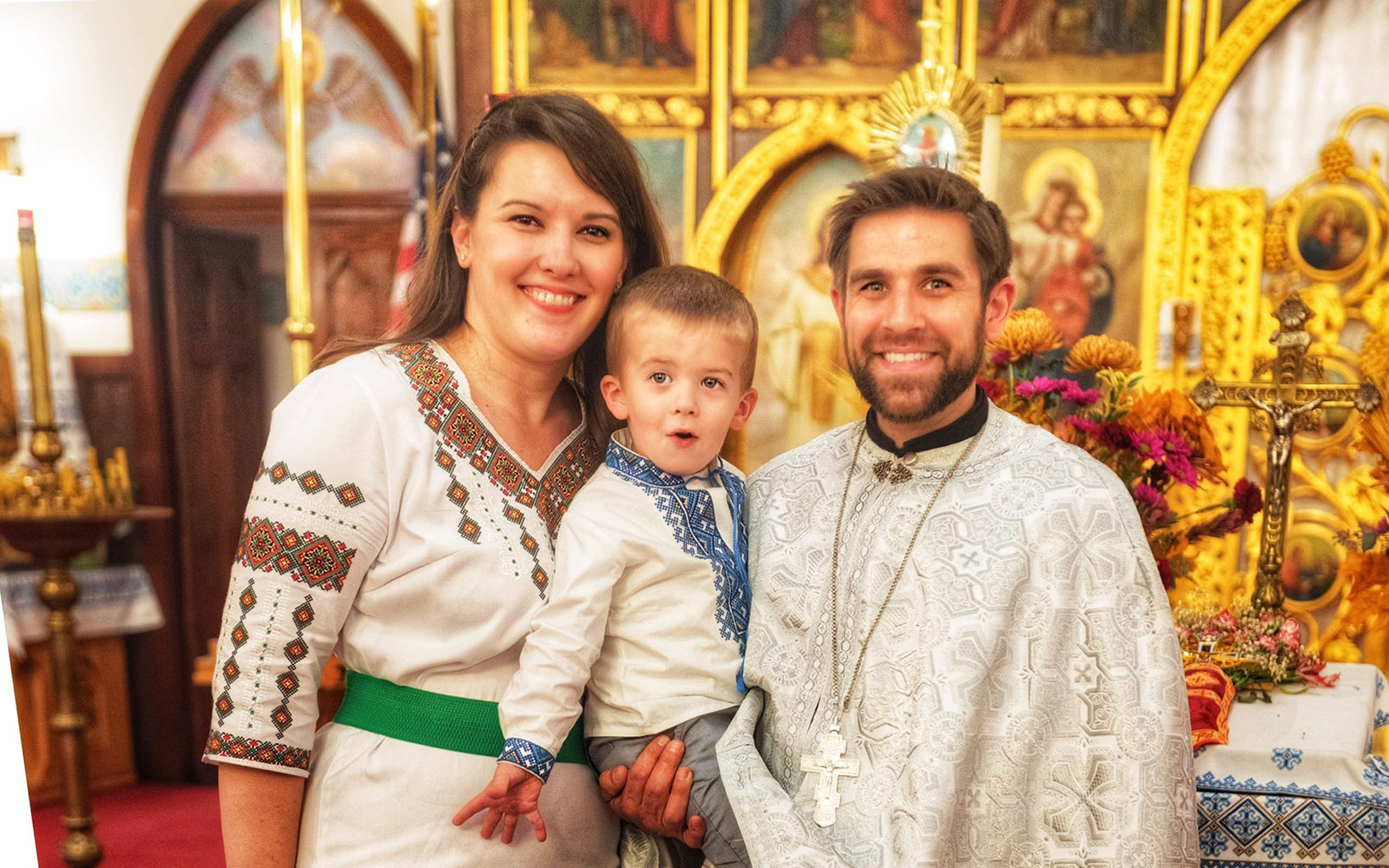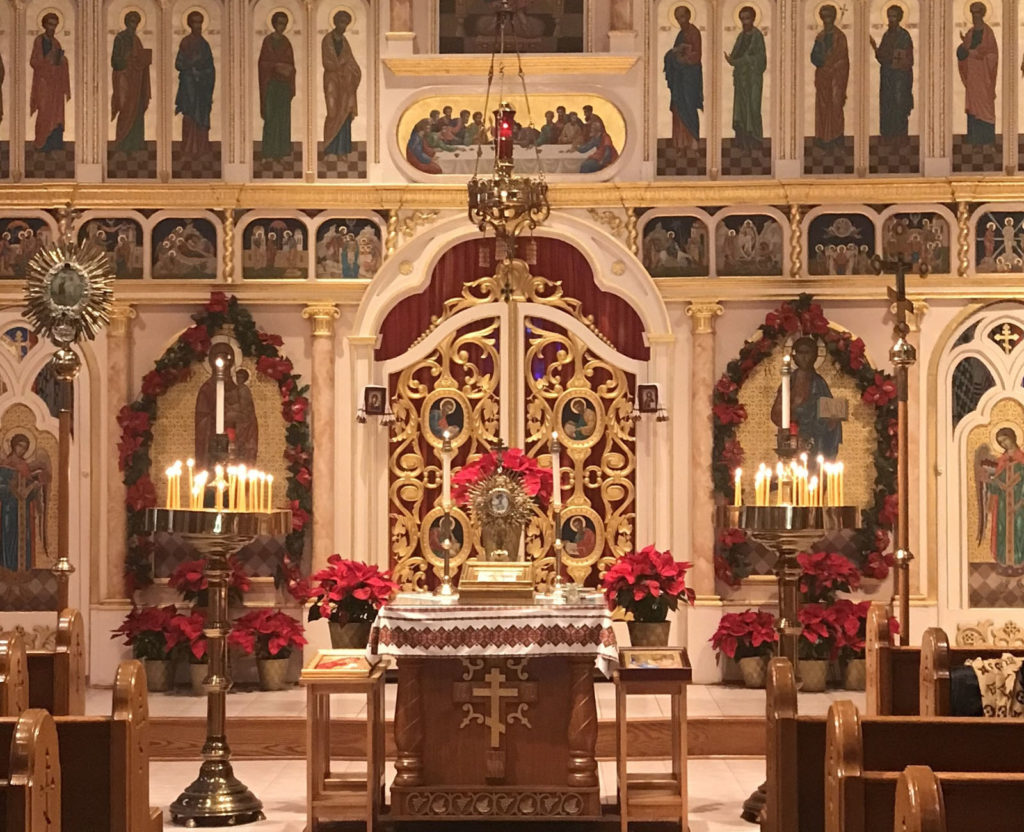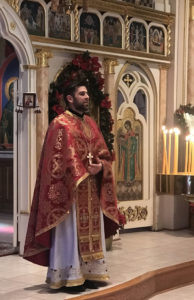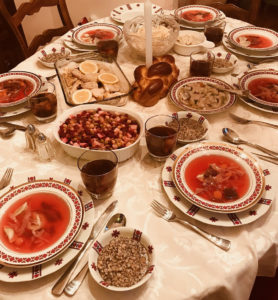
Father John Charest with his wife and son.
By Brianna Horan, Manager of Tourism & Visitor Experience
Cultural Heritage Recipe Box: Ukrainian Orthodox Christmas
It’s unlikely that you’d hear the date of December 25 mentioned without thinking of Christmas day. The date of January 7 may not conjure the same associations, but for Orthodox Christians it marks the day of rejoicing for Jesus Christ’s birth.
The difference in dates comes down to calendars and a lot of history. Orthodox Christianity, which accounts for 12 percent of the world’s Christians, continues to adhere to the Julian Calendar, which was introduced by Julius Caesar. In 1582, Pope Gregory XIII designed a new calendar that today has been adopted by most countries across the globe as their civil calendar. The result is that when the Julius Calendar reads December 25, Gregorian calendars read January 7—a difference of thirteen days.
Orthodox Christmas, or Nativity, is celebrated in January in countries in Eastern Europe and the Middle East, including Russia, Ukraine, Israel, Egypt, Serbia, Belarus, Montenegro, Kazakhstan, Macedonia, Ethiopia, Eritrea, Georgia, and Moldova. While religious faith and rituals unite these worshippers, each country has also developed its own unique ethnic cultural traditions to mark the holiday.
As immigrants from these countries settled in the Pittsburgh region, many established Orthodox churches whose congregations continue to observe the religious practices and ethnic customs today. In Carnegie, St. Peter & St. Paul Ukrainian Orthodox Church organizes several events throughout the year that preserve and share Ukrainian culture, including the annual Pysanky Egg Sale, a Ukrainian Food Festival, a Cookie Walk, and several charitable programs that seek to serve and support the community at large.
“The first thing people should know about Saints Peter and Paul Ukrainian Orthodox Church is not to feel excluded by the word Ukrainian in our name,” says Father John Charest, the church’s priest. “We are a church of our community.” He invites non-parishioners to consider helping to prepare, serve, or deliver the three home-cooked meals the church provides each Memorial Day, Thanksgiving and Christmas. Saints Peter and Paul also organizes an event on the third Sunday of every month where clothing, housewares, children’s toys and more are available at no cost. “It’s open to anyone in the community, whether they want to drop off items they no longer need, or have a need and want to look for something,” Fr. John says. He adds that these opportunities are perfect for high school students who need community service hours, and for anyone wanting to get to know the Carnegie community better.

Saint Peter & St. Paul Ukrainian Orthodox Church decorated for Nativity
The church has regular services on Saturdays at 6 p.m. and Sundays at 9:30 a.m., all of which are streamed live from the church’s website and Facebook live, in addition to holy day services. “Anyone and everyone are welcome to join us for services,” says Fr. John. “The Orthodox Church has a beautiful tradition of singing all the services, and our parish is blessed with a wonderful acapella choir that sings in four-part harmony. Anyone who knows the scriptures well will feel welcome in our services as they are all scripture based, and anyone who would like to get to know the scriptures will feel welcome as we have beautiful services followed by fellowship in our church hall.”
From the kitchen of Father John Charest

Father John Charest
The Holy Supper, Svyat Vechir, is shared on Christmas Eve and is one of the Twelve Great Feasts in the Orthodox Christian faith. This twelve-course meal traditionally consists of all Lenten foods, as observers follow a Nativity Fast that begins on November 28 and concludes at the Liturgy for the Nativity on Christmas Morning. Holy Supper is served at the time of the appearance of the first evening star, symbolizing the Star of Bethlehem, and the twelve courses are meant to represent the Twelve Tribes of Israel and the Twelve Disciples of Christ. The courses are each served separately, ranging from bitter to sweet. Honey is meant to represent the sweet moments in life, garlic the bitter days, grains recall the simple and ordinary moments of life and the Daily Bread.
A Ukrainian sweet grain pudding called kutia is a staple dish that is prepared several ways to mark different Orthodox Christian holy days in the month of January. Made with wheat, berries, honey or sugar, nuts, raisins and poppy seeds, kutia is typically the first food eaten during the Holy Supper on Christmas Eve—but before it’s consumed, some is first tossed to the ceiling. The number of grains that stick to the ceiling are an indicator of how prosperous the agricultural harvest will be in the coming year. Kutia is thought to be among the oldest dishes that is part of the twelve-course meal. It likely originated in Neolithic times, and the first written record of it is found in the twelfth-century Primary Chronicle written by St. Nestor the Chronicler. Over the centuries, kutia has made its way into many rituals. Children traditionally brought a portion of the dish to their grandparents, godparents, and the midwife who delivered them, and when a family went to sleep on Christmas Eve, a bowl of kutia was left on the table for the souls of the deceased to enjoy during the night. If the spoon moved, it meant that they were satisfied with the offering. The father of the house would also leave a portion of kutia in front of the house to bribe Father Frost, the personification of winter, so he would not damage the crops.
Father John describes kutia as halfway between porridge and pudding, and notes that the simple and nutritious dish is served for Christmas Eve, Orthodox New Year’s Eve, and Epiphany/Theophany. A lean version, bahata kutia, is prepared for Christmas Eve, with wheat or barley, poppy seeds, honey, nuts and dried fruit. On Orthodox New Year, January 14, a version called schedra kutia is enriched with butter, milk, or cream, and occasionally a splash of wine, cognac or other alcoholic beverage. The dish is pared down as holodna (hungry) kutia, made only with grains and a small amount of sweetener, on Epiphany, January 18, when a strict fast must be observed.
Just as kutia is a foundation of the so many important traditions in the Orthodox Christian Faith, Father John has also found it to be a connection to his heritage and all those who share it. It also happens to be the main element of a childhood memory that his family looks reminisces about together each Christmas Eve!
“Having moved from the east coast to Chicago, and then to western Pennsylvania, I’ve been a part of various Ukrainian Christmas traditions. Having kutia at the Christmas Eve meal was one of the traditions that I saw wherever I was, even down to the exact location of someone’s home or a church hall, all meals began with kutia. At this point in my life seeing kutia means more than Christmas to me, it means being connected to the Ukrainian people like me, whether they are somewhere here on Earth now, have been on Earth, or will someday be born; we share this rich heritage and are united by it.
“My favorite kutia memory is of the year my brother was in fifth grade. His teacher had the students do reports on ‘Christmas Around the World,’ letting the students choose a country to research. My brother, of course, chose Ukraine. The year he gave his report, Ukraine was part of the USSR and it meant a lot for our family (and others that knew he was presenting) that he was sharing information about a beautiful country that should be independent of the republic. He wore a Ukrainian embroidered shirt, brought an icon of the Nativity, a few sheaths of wheat, and of course, kutia. When he was explaining the significance of the kutia and that there is a tradition of throwing it on the ceiling, his teacher paused the presentation and said, ‘Well… Are you going to throw some on our ceiling?’ He recalls standing frozen and wondering if she was serious. She was, and she encouraged him to take a spoonful out of his presentation and throw it up on the ceiling. The harvest must have been great that year as there was still a spoonful of kutia on the ceiling when my mom came to his class around Easter time to do a pysanky (Ukrainian Easter egg) demonstration. Over 20 years later, when I was substitute teaching at that school, unsure of which room this event took place, I looked at the ceiling of every classroom to which I was assigned to see if I might see the kutia thrown by a proud Ukrainian fifth grader. The story has become a legend in my immediate family and gets retold as we take our first bites of kutia on Christmas Eve.” – Father John Charest
Kutia for Christmas Eve Holy Supper

Holy Supper with Kutia
Serves 4, and takes 90-minutes to prepare.
Each ingredient of kutia has a special symbolism. Wheat stands for resurrection, as the wheat plant must die to be able to be planted and give life to new plants; nuts and poppy seeds are symbols of fertility and prosperity; honey signifies good health and heavenly bliss.
Ingredients
- 2 Tbsp. wheat grains
- 7 oz. poppy seeds
- 7 oz. walnuts
- 5.25 oz. raisins
- 3 Tbsp. honey
Instructions
- Wash the wheat grains thoroughly and let them soak overnight in cold water.
- The next morning, drain and rinse the grains and cook them until tender over low heat, until soft and crumbly.
- Cool the wheat grains and mix them with 1 Tbsp. of honey.
- Place poppy seeds and raisins in separate bowls and soak them in boiling water for 30 minutes.
- Drain the poppy seeds, add 1 Tbsp. of honey, and grind them in a blender.
- Fry the nuts until crispy in a small frying pan.
- Drain the raisins.







